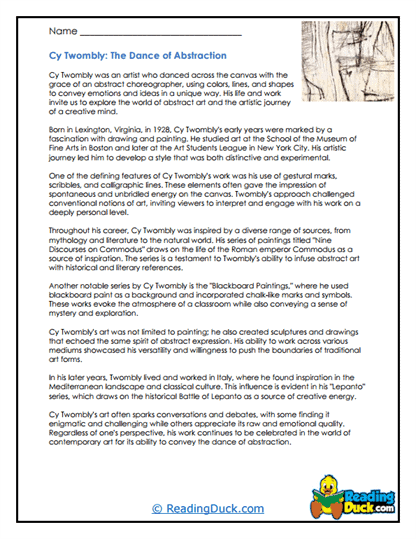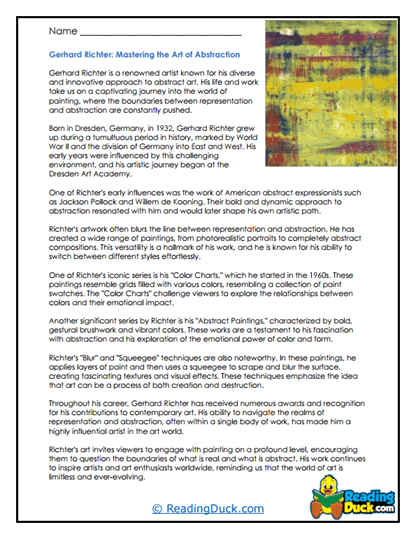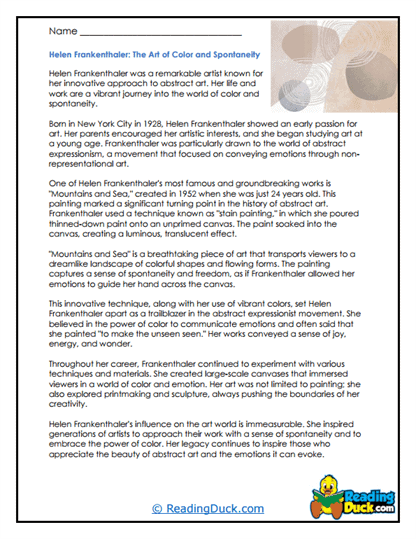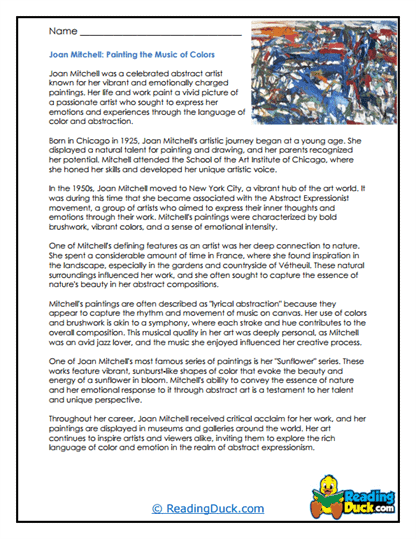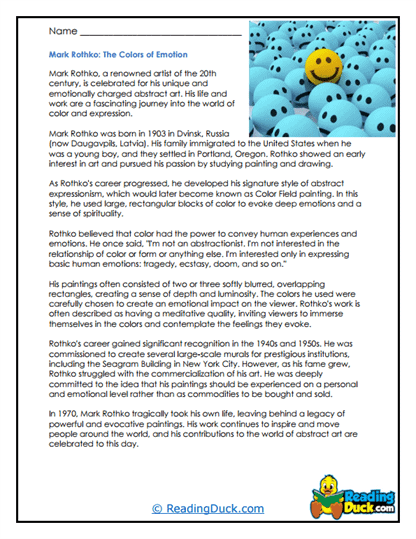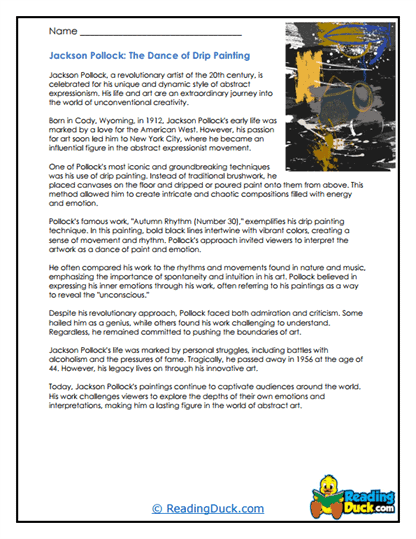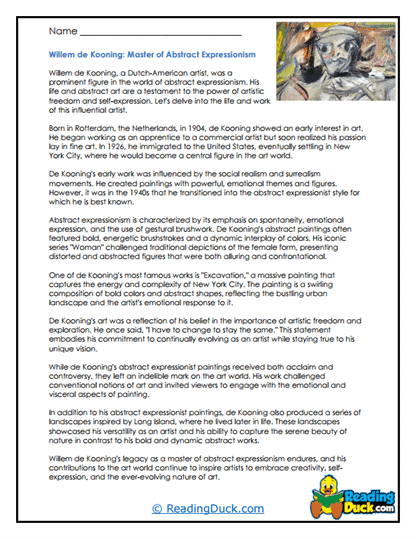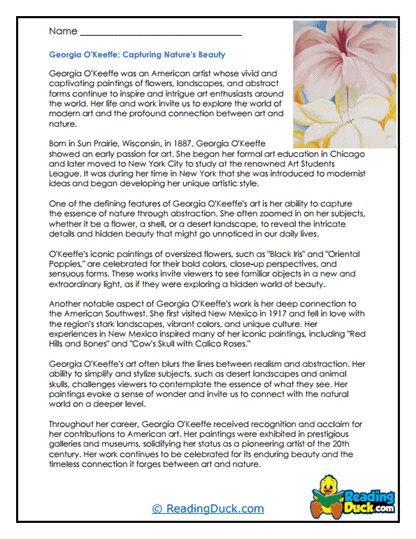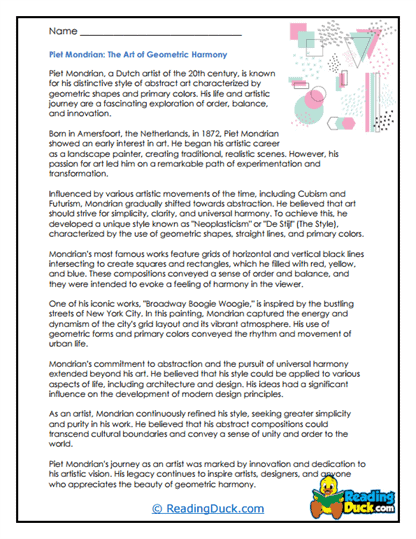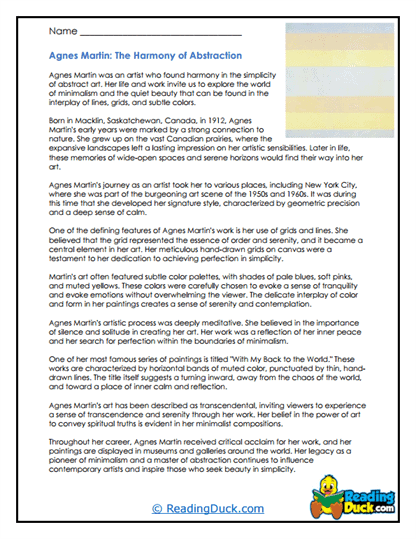Abstract Artists Worksheets
About Our Abstract Artists Worksheets
Our Abstract Artists Worksheets provide an engaging and educational experience for students, immersing them in the world of abstract art while developing critical thinking and comprehension skills. These worksheets are designed to introduce students to key concepts and figures in abstract art, offering them opportunities to explore and reflect on the artistic styles and philosophies that have shaped modern art.
Each worksheet set includes:
- Multiple Choice Questions: These questions help assess the students' understanding of the reading passage, testing their ability to recall specific details, identify main ideas, and interpret the artist's intent.
- Short Answer Questions: Students are prompted to provide concise responses, demonstrating their ability to summarize key points, analyze artistic techniques, and articulate the significance of abstract art in their own words.
- Open-Ended Questions: These questions encourage students to think critically and express their personal opinions, preferences, and interpretations related to abstract art, fostering a deeper connection to the material.
These worksheets serve as a valuable tool for gauging students' comprehension and encouraging a more profound engagement with abstract art. The included answer key for each question sheet ensures that teachers and parents can effectively evaluate students' progress. All worksheets are provided in a convenient PDF format, allowing for easy electronic viewing, downloading, and printing.
Understanding Abstract Art: A Journey Through Creativity and Expression
Abstract art is a fascinating and dynamic genre that breaks away from the traditional representation of objects, people, or landscapes. Instead, it focuses on the use of shapes, colors, forms, and textures to convey ideas, emotions, and perceptions. Abstract art challenges the viewer to interpret and find meaning in compositions that may not have a clear or direct representation, making it a powerful tool for self-expression and creativity.
In exploring abstract art, students can learn about various aspects of this artistic genre:
- History and Evolution of Abstract Art: Students will discover how abstract art emerged in the early 20th century as artists began to experiment with new ways of representing the world around them. Key movements like Cubism, Surrealism, and Expressionism played significant roles in shaping abstract art.
- Famous Abstract Artists: Students will explore the works of renowned abstract artists such as Wassily Kandinsky, Piet Mondrian, and Jackson Pollock. Each of these artists brought unique perspectives and techniques to the genre, influencing how abstract art is perceived today.
- Techniques and Styles: Abstract art is characterized by a wide variety of techniques, from the geometric precision of Mondrian’s compositions to the fluid, expressive brushstrokes of Pollock’s drip paintings. Students will learn about different styles, including abstract expressionism, minimalism, and lyrical abstraction, among others.
- Interpretation and Personal Connection: One of the most exciting aspects of abstract art is the freedom it gives viewers to interpret the artwork in their own way. Students will be encouraged to reflect on how abstract art makes them feel and what personal meanings they can derive from different pieces.
Through this exploration, students will gain an appreciation for the diversity and depth of abstract art, understanding it not just as a visual experience but as a powerful form of communication that transcends language and cultural boundaries.
How Teachers and Parents Can Integrate These Worksheets in a Learning Curriculum
Integrating abstract art into a learning curriculum can be both rewarding and enriching for students. Here are some practical ideas on how these worksheets can be utilized:
- Introduce Abstract Art as a Thematic Unit: Use these worksheets as part of a larger unit on modern art. Begin with a general introduction to abstract art, then delve deeper into specific artists or movements with each worksheet set. This approach allows students to build their knowledge progressively.
- Incorporate Cross-Disciplinary Learning: Abstract art can be connected to other subjects, such as history, literature, or even science. For example, discuss the historical context in which abstract art developed or compare abstract art to literary modernism, highlighting the similarities in the rejection of traditional forms.
- Encourage Creative Projects: After completing the worksheets, encourage students to create their own abstract artworks. This hands-on activity not only reinforces what they’ve learned but also allows them to express their understanding of abstract concepts through their creativity.
- Use Worksheets for Group Discussions: The open-ended questions in these worksheets are perfect for sparking group discussions. Have students share their interpretations of abstract artworks and discuss how different perspectives can lead to varied understandings of the same piece.
- Adapt for Various Grade Levels: For younger students, focus on the basic concepts of abstract art and simple interpretations, while older students can handle more complex analyses of artistic techniques and movements. These worksheets are versatile and can be adapted to suit different age groups and skill levels.
- Homework Assignments or Extra Credit: The worksheets can be used as homework assignments, giving students time to reflect on the material outside the classroom. They can also serve as extra credit for students who wish to delve deeper into abstract art.
- Integrate with Technology: If available, encourage students to research abstract artists and their works online, using digital tools to explore virtual galleries or create digital abstract art. This integration of technology can enhance their learning experience and engagement.
Studying abstract art through these worksheets can significantly enhance students’ critical thinking, creativity, and interpretative skills. By engaging with abstract art, students learn to approach problems from different angles, express their ideas in innovative ways, and appreciate the diversity of human expression. These skills are not only essential for academic success but also contribute to personal growth and development, fostering a lifelong appreciation for the arts.
